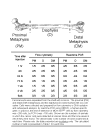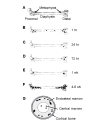Kinetics of metastatic breast cancer cell trafficking in bone
- PMID: 16533765
- PMCID: PMC1523260
- DOI: 10.1158/1078-0432.CCR-05-1806
Kinetics of metastatic breast cancer cell trafficking in bone
Abstract
Purpose: In vivo studies have focused on the latter stages of the bone metastatic process (osteolysis), whereas little is known about earlier events, e.g., arrival, localization, and initial colonization. Defining these initial steps may potentially identify the critical points susceptible to therapeutic intervention.
Experimental design: MDA-MB-435 human breast cancer cells engineered with green fluorescent protein were injected into the cardiac left ventricle of athymic mice. Femurs were analyzed by fluorescence microscopy, immunohistochemistry, real-time PCR, flow cytometry, and histomorphometry at times ranging from 1 hour to 6 weeks.
Results: Single cells were found in distal metaphyses at 1 hour postinjection and remained as single cells up to 72 hours. Diaphyseal arrest occurred rarely and few cells remained there after 24 hours. At 1 week, numerous foci (2-10 cells) were observed, mostly adjacent to osteoblast-like cells. By 2 weeks, fewer but larger foci (> or =50 cells) were seen. Most bones had a single large mass at 4 weeks (originating from a colony or coalescing foci) which extended into the diaphysis by 4 to 6 weeks. Little change (<20%) in osteoblast or osteoclast numbers was observed at 2 weeks, but at 4 to 6 weeks, osteoblasts were dramatically reduced (8% of control), whereas osteoclasts were reduced modestly (to approximately 60% of control).
Conclusions: Early arrest in metaphysis and minimal retention in diaphysis highlight the importance of the local milieu in determining metastatic potential. These results extend the Seed and Soil hypothesis by demonstrating both intertissue and intratissue differences governing metastatic location. Ours is the first in vivo evidence that tumor cells influence not only osteoclasts, as widely believed, but also eliminate functional osteoblasts, thereby restructuring the bone microenvironment to favor osteolysis. The data may also explain why patients receiving bisphosphonates fail to heal bone despite inhibiting resorption, implying that concurrent strategies that restore osteoblast function are needed to effectively treat osteolytic bone metastases.
Figures





Similar articles
-
Modifying the osteoblastic niche with zoledronic acid in vivo-potential implications for breast cancer bone metastasis.Bone. 2014 Sep;66(100):240-50. doi: 10.1016/j.bone.2014.06.023. Epub 2014 Jun 24. Bone. 2014. PMID: 24971713 Free PMC article.
-
Angiogenesis inhibitor TNP-470 inhibits human breast cancer osteolytic bone metastasis in nude mice through the reduction of bone resorption.Cancer Res. 1998 Feb 1;58(3):462-7. Cancer Res. 1998. PMID: 9458090
-
A small molecule antagonist of the alpha(v)beta3 integrin suppresses MDA-MB-435 skeletal metastasis.Clin Exp Metastasis. 2004;21(2):119-28. doi: 10.1023/b:clin.0000024763.69809.64. Clin Exp Metastasis. 2004. PMID: 15168729
-
Biological aspects of altered bone remodeling in multiple myeloma and possibilities of pharmacological intervention.Dan Med Bull. 2011 May;58(5):B4277. Dan Med Bull. 2011. PMID: 21535989 Review.
-
Breast cancer metastasis to bone: From epithelial to mesenchymal transition to breast osteoblast-like cells.Semin Cancer Biol. 2021 Jul;72:155-164. doi: 10.1016/j.semcancer.2020.01.004. Epub 2020 Feb 8. Semin Cancer Biol. 2021. PMID: 32045651 Review.
Cited by
-
Combined micro CT and histopathology for evaluation of skeletal metastasis in live animals.Am J Transl Res. 2015 Feb 15;7(2):348-55. eCollection 2015. Am J Transl Res. 2015. PMID: 25901201 Free PMC article.
-
Mechanical and Mechanosensing Properties of Tumor Affected Bone Cells Were Inhibited via PI3K/Akt Pathway.J Bone Metab. 2019 Aug;26(3):179-191. doi: 10.11005/jbm.2019.26.3.179. Epub 2019 Aug 31. J Bone Metab. 2019. PMID: 31555615 Free PMC article.
-
Tumor metastasis to bone.Arthritis Res Ther. 2007;9 Suppl 1(Suppl 1):S5. doi: 10.1186/ar2169. Arthritis Res Ther. 2007. PMID: 17634144 Free PMC article. Review.
-
Breast cancer cells induce osteolytic bone lesions in vivo through a reduction in osteoblast activity in mice.PLoS One. 2013 Sep 12;8(9):e68103. doi: 10.1371/journal.pone.0068103. eCollection 2013. PLoS One. 2013. PMID: 24069136 Free PMC article.
-
Pre-Osteoblasts Stimulate Migration of Breast Cancer Cells via the HGF/MET Pathway.PLoS One. 2016 Mar 2;11(3):e0150507. doi: 10.1371/journal.pone.0150507. eCollection 2016. PLoS One. 2016. PMID: 26934743 Free PMC article.
References
-
- Body JJ. Metastatic bone disease: clinical and therapeutic aspects. Bone. 1992;13 (Suppl 1):S57–S62. - PubMed
-
- Coleman RE. Skeletal complications of malignancy. Cancer. 1997;80:1588–94. - PubMed
-
- Mundy GR. Metastasis: Metastasis to bone: causes, consequences and therapeutic opportunities. Nature Rev Cancer. 2002;2:584–93. - PubMed
-
- Lelekakis M, Moseley JM, Martin TJ, et al. A novel orthotopic model of breast cancer metastasis to bone. Clin Exptl Metastasis. 1999;17:163–70. - PubMed
Publication types
MeSH terms
Substances
Grants and funding
LinkOut - more resources
Full Text Sources
Other Literature Sources
Medical
Miscellaneous

